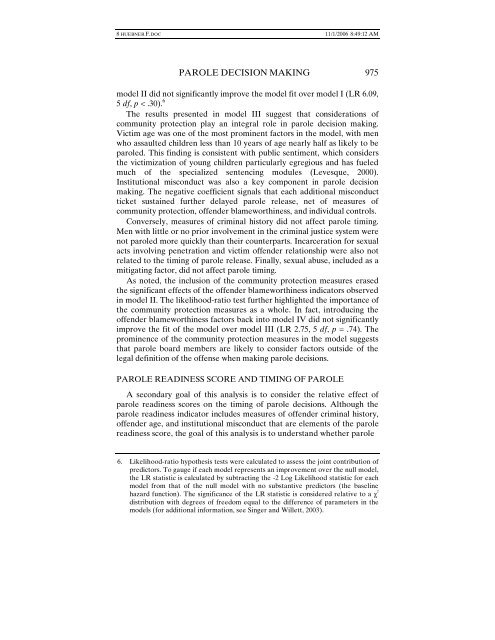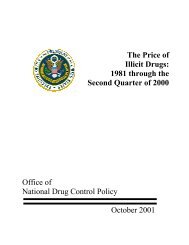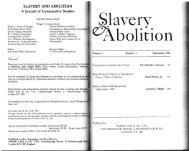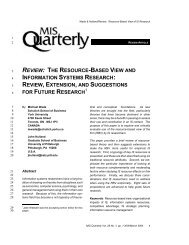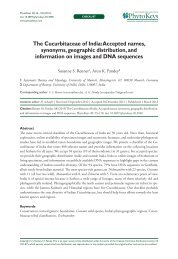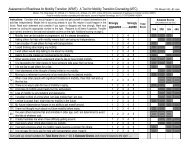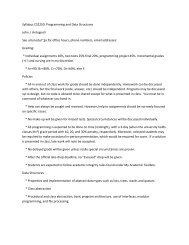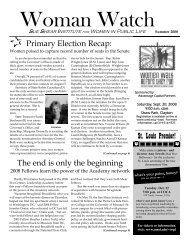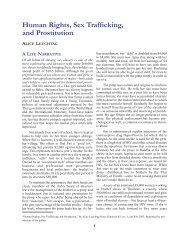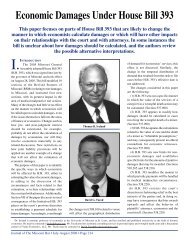an analysis of parole decision making using a sample of sex offenders
an analysis of parole decision making using a sample of sex offenders
an analysis of parole decision making using a sample of sex offenders
You also want an ePaper? Increase the reach of your titles
YUMPU automatically turns print PDFs into web optimized ePapers that Google loves.
8 HUEBNER F.DOC 11/1/2006 8:49:12 AM<br />
PAROLE DECISION MAKING 975<br />
model II did not signific<strong>an</strong>tly improve the model fit over model I (LR 6.09,<br />
5 df, p < .30). 6<br />
The results presented in model III suggest that considerations <strong>of</strong><br />
community protection play <strong>an</strong> integral role in <strong>parole</strong> <strong>decision</strong> <strong>making</strong>.<br />
Victim age was one <strong>of</strong> the most prominent factors in the model, with men<br />
who assaulted children less th<strong>an</strong> 10 years <strong>of</strong> age nearly half as likely to be<br />
<strong>parole</strong>d. This finding is consistent with public sentiment, which considers<br />
the victimization <strong>of</strong> young children particularly egregious <strong>an</strong>d has fueled<br />
much <strong>of</strong> the specialized sentencing modules (Levesque, 2000).<br />
Institutional misconduct was also a key component in <strong>parole</strong> <strong>decision</strong><br />
<strong>making</strong>. The negative coefficient signals that each additional misconduct<br />
ticket sustained further delayed <strong>parole</strong> release, net <strong>of</strong> measures <strong>of</strong><br />
community protection, <strong>of</strong>fender blameworthiness, <strong>an</strong>d individual controls.<br />
Conversely, measures <strong>of</strong> criminal history did not affect <strong>parole</strong> timing.<br />
Men with little or no prior involvement in the criminal justice system were<br />
not <strong>parole</strong>d more quickly th<strong>an</strong> their counterparts. Incarceration for <strong>sex</strong>ual<br />
acts involving penetration <strong>an</strong>d victim <strong>of</strong>fender relationship were also not<br />
related to the timing <strong>of</strong> <strong>parole</strong> release. Finally, <strong>sex</strong>ual abuse, included as a<br />
mitigating factor, did not affect <strong>parole</strong> timing.<br />
As noted, the inclusion <strong>of</strong> the community protection measures erased<br />
the signific<strong>an</strong>t effects <strong>of</strong> the <strong>of</strong>fender blameworthiness indicators observed<br />
in model II. The likelihood-ratio test further highlighted the import<strong>an</strong>ce <strong>of</strong><br />
the community protection measures as a whole. In fact, introducing the<br />
<strong>of</strong>fender blameworthiness factors back into model IV did not signific<strong>an</strong>tly<br />
improve the fit <strong>of</strong> the model over model III (LR 2.75, 5 df, p = .74). The<br />
prominence <strong>of</strong> the community protection measures in the model suggests<br />
that <strong>parole</strong> board members are likely to consider factors outside <strong>of</strong> the<br />
legal definition <strong>of</strong> the <strong>of</strong>fense when <strong>making</strong> <strong>parole</strong> <strong>decision</strong>s.<br />
PAROLE READINESS SCORE AND TIMING OF PAROLE<br />
A secondary goal <strong>of</strong> this <strong>an</strong>alysis is to consider the relative effect <strong>of</strong><br />
<strong>parole</strong> readiness scores on the timing <strong>of</strong> <strong>parole</strong> <strong>decision</strong>s. Although the<br />
<strong>parole</strong> readiness indicator includes measures <strong>of</strong> <strong>of</strong>fender criminal history,<br />
<strong>of</strong>fender age, <strong>an</strong>d institutional misconduct that are elements <strong>of</strong> the <strong>parole</strong><br />
readiness score, the goal <strong>of</strong> this <strong>an</strong>alysis is to underst<strong>an</strong>d whether <strong>parole</strong><br />
6. Likelihood-ratio hypothesis tests were calculated to assess the joint contribution <strong>of</strong><br />
predictors. To gauge if each model represents <strong>an</strong> improvement over the null model,<br />
the LR statistic is calculated by subtracting the -2 Log Likelihood statistic for each<br />
model from that <strong>of</strong> the null model with no subst<strong>an</strong>tive predictors (the baseline<br />
hazard function). The signific<strong>an</strong>ce <strong>of</strong> the LR statistic is considered relative to a χ 2<br />
distribution with degrees <strong>of</strong> freedom equal to the difference <strong>of</strong> parameters in the<br />
models (for additional information, see Singer <strong>an</strong>d Willett, 2003).


